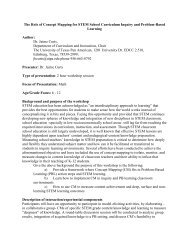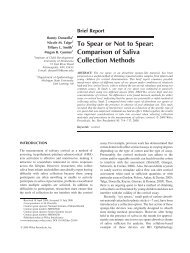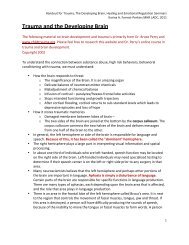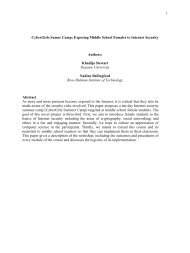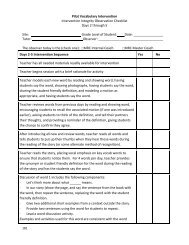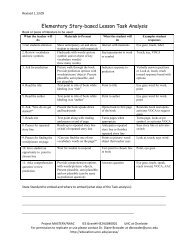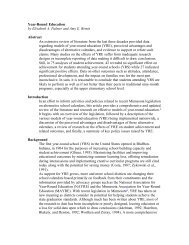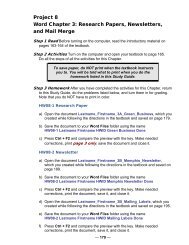Introduction to Positive Ways of Intervening with Challenging Behavior
Introduction to Positive Ways of Intervening with Challenging Behavior
Introduction to Positive Ways of Intervening with Challenging Behavior
Create successful ePaper yourself
Turn your PDF publications into a flip-book with our unique Google optimized e-Paper software.
Emmer, E.T., et al. (1994). Classroom management for secondary teachers (3rd ed.). Needham<br />
Heights, MA: Allyn and Bacon.<br />
Eyde, D.R. (1982). <strong>Positive</strong> approaches <strong>to</strong> behavior management: Monograph 5. Drake<br />
University, Des Moines: Midwest Regional Resource Center. ED231-114.<br />
Forness, Youpa, Hanna, Cantwell, & Swanson (1992). Classroom instructional characteristics in<br />
attention deficit hyperactivity disorder: Comparison <strong>of</strong> pure and mixed subgroups. <strong>Behavior</strong>al Disorders,<br />
17, 115-25.<br />
Howard, W.L., Heron, T.E., Ellis, D.E., & Cooke, N.L. (1986). Teaching forst grade peer tu<strong>to</strong>rs<br />
<strong>to</strong> use verbal praise on an intermittent schedule. Education and Treatment <strong>of</strong> Children, 9, 5-15.<br />
James, D.A. (1990). <strong>Behavior</strong> modification project: Reducing and controlling calling out<br />
behaviors. ED 319 171.<br />
Johnson, D.W., & Johnson, R.T. (1991). Cooperation in the classroom. Edina, MN: Interaction<br />
Book Company.<br />
Jones, V.F., & Jones, L.S. (1986). Comprehensive classroom management: Creating positive<br />
learning environments (2nd ed.). Bos<strong>to</strong>n: Allyn and Bacon.<br />
Jorgensen, E.S. (1978). Cross-age, multicultural peer tu<strong>to</strong>ring in an elementary resource room.<br />
ED153 419.<br />
Kerr, M.M., & Nelson, C.M. (1989). Strategies for managing behavior problems in the<br />
classroom (2nd ed.). New York: MacMillan.<br />
LaVigna, G.W., & Donnellan, A.M. (1986). Alternative <strong>to</strong> punishment: Solving behavior<br />
problems <strong>with</strong> non-aversive strategies. Irving<strong>to</strong>n Publishers.<br />
Mash, E.J., & Terdal, L.G. (1988). <strong>Behavior</strong>al assessment <strong>of</strong> childhood disorders, second<br />
edition. New York: The Guilford Press.<br />
Medick, J.M. (1979). Effective classroom management for three problem behaviors: Hostileaggressive,<br />
passive-aggressive, and <strong>with</strong>drawn failure-image. East Lansing, MI: Institute for Research<br />
on Teaching, Michigan State University. ED186835<br />
Medick, J.M. (1982). The loving teacher's guide <strong>to</strong> discipline. Instruc<strong>to</strong>r, 92, 66-68, 70.<br />
O’Leary, K.D., & O’Leary, S.G. (1977). Classroom management: The successful use <strong>of</strong> behavior<br />
modification (2nd ed.). New York: Pergamon Press Inc.<br />
Rogers, B. (1990). “You know the fair rule”: Strategies for making the hard job <strong>of</strong> discipline in<br />
school easier. Harlow, England: Longman.




